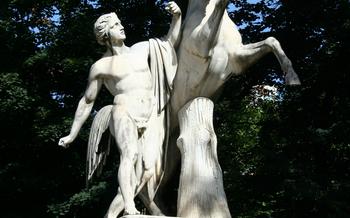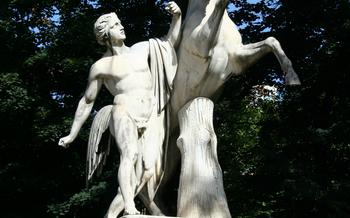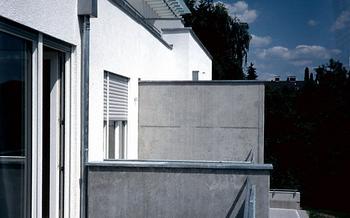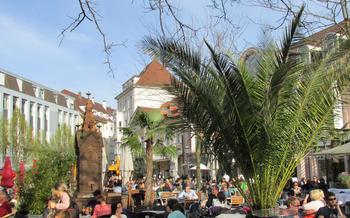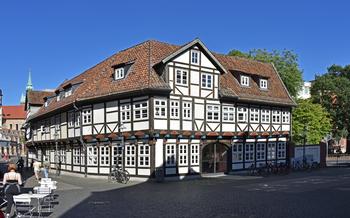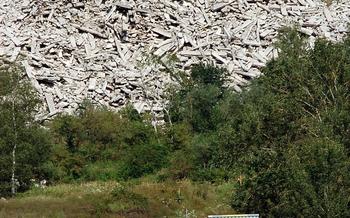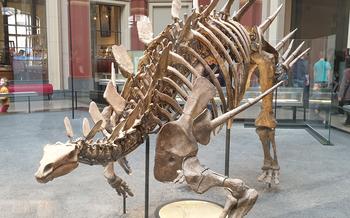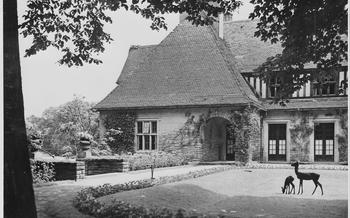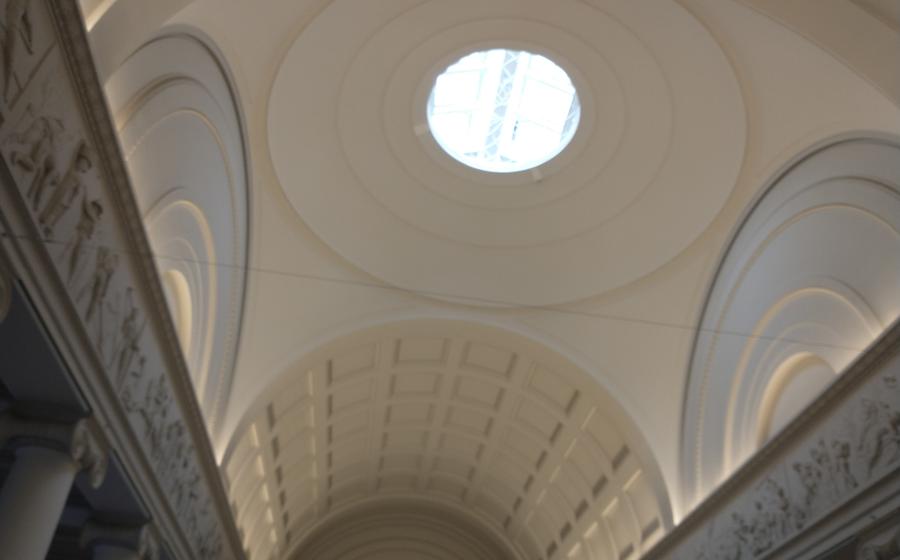
The State Museum of Natural History Stuttgart
- The State Museum of Natural History Stuttgart: A Journey Through Nature and Science
- Exhibitions: Unveiling the Wonders of the Natural World
- Dinosaurs and Fossils: A Glimpse into Prehistory
- Biodiversity and Ecosystems: Exploring the Living World
- Minerals and Gemstones: The Earth's Treasures
- Human Biology and Evolution: Understanding Ourselves
- Space and Astronomy: Reaching for the Stars
- Guided Tours: Enriching Your Museum Experience
- Educational Programs: Fostering a Love for Nature
- Research and Conservation: Preserving Our Natural Heritage
- Accessibility and Inclusivity: Welcoming All Visitors
- Visitor Services and Amenities: Ensuring a Comfortable Visit
- Location and Transportation: Getting to the Museum
- Hours of Operation and Admission Fees: Planning Your Visit
- Insider Tip: Unforgettable Experiences Await
The State Museum of Natural History Stuttgart: A Journey Through Nature and Science
The State Museum of Natural History Stuttgart, founded in 1861, is a renowned institution dedicated to preserving and showcasing the wonders of the natural world. Its journey began with a modest collection of minerals and fossils, which has since expanded into a vast repository of specimens, artifacts, and exhibits that span the realms of paleontology, zoology, mineralogy, and astronomy. The museum's mission is to inspire curiosity, promote understanding, and foster a sense of responsibility for the natural environment through its diverse range of exhibitions, educational programs, and research initiatives.
As a cornerstone of Stuttgart's cultural landscape, the State Museum of Natural History plays a crucial role in educating and engaging the local community and visitors from around the world. It serves as a hub for scientific research, collaborating with universities, research institutions, and conservation organizations to advance our knowledge of the natural world and contribute to its preservation.
Among its many unique features, the museum boasts an impressive collection of dinosaur fossils, interactive exhibits that bring science to life, and a planetarium that offers immersive experiences of the cosmos. With its commitment to excellence in research, education, and public engagement, the State Museum of Natural History Stuttgart stands as a testament to the power of science and the importance of preserving our natural heritage.
Exhibitions: Unveiling the Wonders of the Natural World
The State Museum of Natural History Stuttgart boasts an array of captivating exhibitions that delve into the wonders of the natural world. Permanent exhibitions form the core of the museum's offerings, showcasing key themes such as biodiversity, evolution, and the Earth's history. Visitors can embark on a journey through time, exploring the origins of life on Earth and tracing the remarkable diversity of species that have inhabited our planet. Interactive exhibits bring these concepts to life, allowing visitors to engage with the natural world through hands-on experiences.
Temporary exhibitions add a dynamic element to the museum's offerings, presenting curated experiences and special events that delve into specific topics or showcase groundbreaking research. These exhibitions often feature collaborations with renowned scientists, artists, and institutions, offering visitors a unique perspective on the latest developments in the natural sciences.
Educational programs and workshops complement the museum's exhibitions, providing opportunities for visitors of all ages to learn and grow. Interactive workshops, lectures, and demonstrations allow participants to delve deeper into specific areas of interest, foster a love for nature, and gain a deeper understanding of the natural world.
Dinosaurs and Fossils: A Glimpse into Prehistory
Journey back in time and witness the grandeur of prehistoric giants at the State Museum of Natural History Stuttgart. The museum boasts an impressive collection of dinosaur fossils, including the iconic Triceratops, whose imposing skull is a testament to the majesty of these ancient creatures. Interactive exhibits allow visitors to explore paleontological techniques, uncovering the secrets of how these fossils were discovered and preserved.
Stroll through the halls and marvel at the diverse array of dinosaur species, each with its unique adaptations and characteristics. Learn about the evolution of life on Earth, from the humble beginnings of single-celled organisms to the dominance of dinosaurs and their eventual extinction. Witness the fossilized remains of ancient plants, insects, and marine creatures, providing a glimpse into the vibrant ecosystems of the past.
Engage in hands-on activities that bring paleontology to life. Unearth virtual fossils, assemble dinosaur skeletons, and operate interactive displays that simulate the work of paleontologists. Discover the challenges and rewards of fossil hunting and gain insights into the ongoing research that continues to shed light on the prehistoric world.
Biodiversity and Ecosystems: Exploring the Living World
The State Museum of Natural History Stuttgart celebrates the wonders of biodiversity and ecosystems through its captivating exhibits. Journey through diverse habitats, from lush rainforests to vibrant coral reefs, and discover the incredible array of plant and animal life that call these ecosystems home.
Interactive displays bring the natural world to life, allowing visitors to explore the intricate relationships between species and their environments. Learn about the interdependence of organisms, the importance of food chains, and the delicate balance that maintains the health of our planet.
Educational programs focused on conservation and sustainability empower visitors to make informed choices and contribute to the preservation of our natural heritage. Workshops, lectures, and hands-on activities provide insights into the challenges facing ecosystems and inspire visitors to become active stewards of the environment.
The museum collaborates with local and international organizations to support research and conservation efforts. Visitors can learn about ongoing projects, meet with experts, and contribute to the collective effort to protect and restore our planet's biodiversity.
Minerals and Gemstones: The Earth's Treasures
The State Museum of Natural History Stuttgart boasts an extensive collection of minerals and gemstones from around the world, captivating visitors with their beauty, rarity, and scientific significance. Interactive exhibits demonstrate the properties and uses of minerals, showcasing their applications in various fields such as jewelry, technology, and industry. Educational programs introduce visitors to the world of mineralogy, fostering an appreciation for these natural wonders and their role in human civilization.
The museum collaborates with mineralogical societies and institutions to conduct research, contribute to the understanding of mineral formation and diversity, and promote conservation efforts. Visitors can learn about the geological processes responsible for the creation of minerals, their chemical composition, and their importance in understanding the Earth's history.
The museum's collection includes stunning gemstones such as diamonds, rubies, sapphires, and emeralds, showcasing the natural artistry and value of these precious stones. Interactive displays allow visitors to explore the factors that determine the value of gemstones, including their color, clarity, cut, and carat weight.
Through its collection and educational programs, the State Museum of Natural History Stuttgart inspires curiosity, wonder, and a deeper appreciation for the Earth's mineral treasures.
Human Biology and Evolution: Understanding Ourselves
The State Museum of Natural History Stuttgart delves into the complexities of human biology and evolution, inviting visitors to explore the intricate workings of our bodies, our genetic heritage, and the remarkable journey of human evolution. Through interactive exhibits, educational programs, and cutting-edge research, the museum provides a comprehensive understanding of what it means to be human.
Exhibits on human biology showcase the body's systems, from the intricate workings of the cardiovascular and nervous systems to the marvels of cellular processes. Visitors can explore the mysteries of genetics, learning about the role of DNA in shaping our traits and understanding the complexities of human health and disease. Interactive displays allow visitors to engage with the exhibits, conducting virtual experiments and delving deeper into the wonders of human biology.
The museum's exploration of human evolution takes visitors on a fascinating journey through time, from our humble origins as primates to the development of modern humans. Fossil displays showcase the remarkable diversity of our ancestors, highlighting the evolutionary adaptations that allowed us to thrive in different environments. Interactive exhibits invite visitors to become paleontologists, analyzing fossils and piecing together the puzzle of human evolution.
Educational programs and workshops at the museum focus on promoting healthy living and well-being, empowering visitors to make informed choices about their health. Topics range from nutrition and exercise to genetics and disease prevention. The museum also collaborates with medical and scientific institutions to conduct cutting-edge research on human biology and evolution, contributing to our understanding of ourselves and the challenges we face in the modern world.
Space and Astronomy: Reaching for the Stars
Venture into the vast expanse of the universe at the State Museum of Natural History Stuttgart's captivating space and astronomy exhibits. Gaze upon intricate models of planets, marvel at the grandeur of galaxies, and learn about the mysteries of the cosmos. Interactive displays simulate space travel and astronomical phenomena, allowing you to experience the thrill of exploration firsthand. Educational programs inspire visitors to dream big, igniting a passion for the wonders that lie beyond our world. The museum fosters collaboration with astronomical observatories and agencies, contributing to the advancement of our understanding of the universe. Join the journey of cosmic discovery and let your imagination soar among the stars.
Guided Tours: Enriching Your Museum Experience
Enhance your visit to the State Museum of Natural History Stuttgart by joining a guided tour. Led by knowledgeable and enthusiastic guides, these tours offer a deeper understanding of the museum's exhibits and collections. Available in various languages, the guided tours cater to visitors from all over the world.
Thematic tours focus on specific topics or areas of interest, allowing you to delve into the museum's vast collection. Whether you are fascinated by dinosaurs, minerals, or space, these specialized tours provide an in-depth exploration of your chosen subject.
For an exclusive glimpse into the museum's behind-the-scenes operations, consider booking a behind-the-scenes tour. These tours take you to areas not accessible to the general public, offering a unique perspective on the museum's work. Learn about the curatorial process, conservation efforts, and ongoing research projects.
Advance booking is recommended for guided tours, especially for groups and during peak season. Take advantage of group discounts and special rates for families. With its engaging and informative guided tours, the State Museum of Natural History Stuttgart offers an unforgettable experience for visitors of all ages.
Educational Programs: Fostering a Love for Nature
The State Museum of Natural History Stuttgart places a strong emphasis on education, aiming to inspire visitors of all ages to explore and appreciate the natural world. A variety of educational programs and initiatives cater to different audiences and interests, promoting a lifelong love for nature and science.
For children and families, the museum offers a range of age-appropriate activities and workshops. These interactive programs cover various topics, from dinosaur discoveries to the wonders of the human body. Children can participate in hands-on experiments, storytelling sessions, and creative workshops, fostering their curiosity and encouraging them to learn through play.
School programs are closely aligned with educational curricula, providing teachers with valuable resources and materials to enhance classroom lessons. Guided tours tailored to specific grade levels bring the museum's exhibits to life, allowing students to engage with the natural world in a dynamic and interactive way.
Summer camps and holiday programs offer children and teenagers the opportunity to immerse themselves in nature and science during school breaks. These programs combine fun and learning, with activities such as outdoor exploration, fossil hunting, and scientific experiments.
The museum collaborates with educational institutions and organizations to develop innovative programs and resources. These partnerships ensure that the museum's educational offerings are relevant, engaging, and aligned with the latest scientific discoveries and research.
Research and Conservation: Preserving Our Natural Heritage
The State Museum of Natural History Stuttgart is deeply committed to scientific research and conservation efforts. Its team of experts actively engages in a wide range of projects aimed at understanding and protecting our natural heritage. Collaborations with universities, research institutes, and conservation organizations are essential to the museum's research endeavors. These partnerships contribute to the advancement of knowledge in various fields, including biodiversity, paleontology, mineralogy, and astronomy.
The museum's research activities extend beyond the walls of its building. Scientists conduct fieldwork, expeditions, and surveys to study ecosystems, species, and geological formations in different parts of the world. This hands-on approach allows them to gather valuable data, contribute to scientific publications, and inform conservation strategies. Through its research, the museum contributes to the understanding and protection of biodiversity, promoting sustainable practices and raising awareness about environmental issues.
The museum also plays a crucial role in public engagement and awareness-raising. It organizes exhibitions, workshops, and lectures to educate visitors about the importance of biodiversity and the need for conservation. By fostering a sense of wonder and appreciation for the natural world, the museum inspires visitors to become active stewards of the environment.
Accessibility and Inclusivity: Welcoming All Visitors
The State Museum of Natural History Stuttgart embraces inclusivity and accessibility, ensuring that all visitors have a welcoming and fulfilling experience. The museum is fully accessible for visitors with disabilities, featuring barrier-free entrances, ramps, and elevators. Multilingual signage and audio guides are available in several languages, allowing international visitors to navigate the museum with ease. To cater to families and children, the museum offers special programs and events designed to engage and educate young minds. Accessibility information is readily available on the museum's website, ensuring that visitors can plan their visit accordingly.
Visitor Services and Amenities: Ensuring a Comfortable Visit
The State Museum of Natural History Stuttgart offers a range of visitor services and amenities to ensure a comfortable and enjoyable experience for all guests. The museum shop provides a diverse selection of souvenirs, educational materials, and books related to natural history and science, allowing visitors to take home a piece of their museum experience.
For those seeking refreshments or a bite to eat, the museum café and restaurant offer a variety of options, from light snacks to full meals. Visitors can relax and refuel while enjoying the ambiance of the museum surroundings. Cloakroom and locker facilities are available for storing personal belongings, ensuring a hassle-free visit.
At the information desk, friendly and knowledgeable staff members are ready to assist visitors with any inquiries or provide guidance on navigating the museum's exhibits and collections. Multilingual signage and audio guides are available for international visitors, ensuring that everyone can fully appreciate the museum's offerings.
The museum's commitment to accessibility extends to visitors with disabilities. Barrier-free access is provided throughout the museum, including ramps, elevators, and accessible restrooms. Special programs and events are also organized to cater to the needs of families and children, making the museum a welcoming space for visitors of all ages and abilities.
Location and Transportation: Getting to the Museum
The State Museum of Natural History Stuttgart is conveniently located in the heart of the city, within walking distance of the main train station (Hauptbahnhof) and other public transportation hubs. The museum's address is Löwentorstraße 32, 70190 Stuttgart.
For those arriving by car, there are several parking garages nearby, including the Q-Park Stadtmitte and the Parkhaus Gerber. Detailed directions and parking information can be found on the museum's website.
Whether you choose to come by public transportation, car, or on foot, the museum is easily accessible and offers a central location for visitors to explore.
Hours of Operation and Admission Fees: Planning Your Visit
The State Museum of Natural History Stuttgart welcomes visitors from all over the world with open arms. Plan your visit to ensure a seamless and enjoyable experience. The museum's doors are open Tuesday through Sunday, from 9 am to 5 pm. On special days and during holidays, the hours may vary, so it's always advisable to check the museum's website for the most up-to-date information.
Admission fees are structured to make the museum accessible to everyone. Regular admission for adults is set at a reasonable price, while students, seniors, and families can take advantage of discounted rates. To save time and secure your entry, consider purchasing tickets online in advance. The museum's website provides a convenient platform for online ticketing, allowing you to choose your preferred date and time.
Remember, the State Museum of Natural History Stuttgart is a treasure trove of knowledge and wonder. Plan your visit wisely, immerse yourself in the exhibitions, and let the museum ignite your passion for the natural world.
Insider Tip: Unforgettable Experiences Await
To make the most of your visit to the State Museum of Natural History Stuttgart, consider joining one of the captivating guided night tours. Led by knowledgeable museum educators, these exclusive tours offer a unique perspective on the exhibits, revealing hidden stories and insights that bring the museum's collections to life.
Plan your visit to coincide with one of the museum's many special events, exhibitions, or workshops. These events offer an opportunity to delve deeper into specific topics and engage with experts in the field. Check the museum's website for upcoming events and plan your visit accordingly.
For researchers and enthusiasts, the State Museum of Natural History Stuttgart offers a wealth of resources. Access the museum's extensive library, housing a vast collection of books, journals, and research papers. Collaborate with the museum's curators and scientists, who are actively engaged in cutting-edge research projects. Join the museum's community of researchers and enthusiasts to contribute to the understanding and preservation of our natural world.
